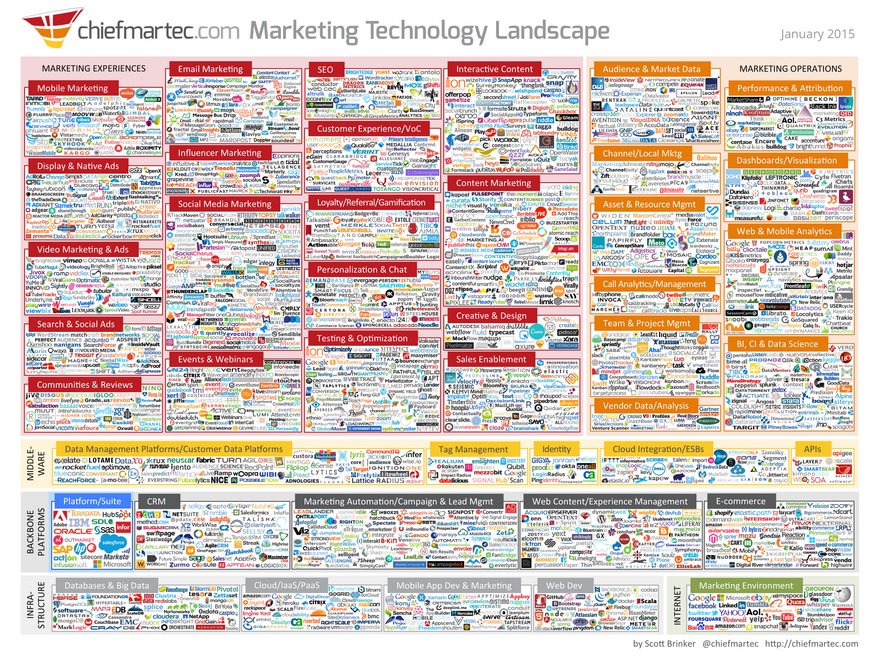Want smarter insights in your inbox? Sign up for our weekly newsletters to get only what matters to enterprise AI, data, and security leaders. Subscribe Now
Chief marketing officers are blessed and cursed at the same time with all the data coming at them.
They are blessed because, as the buyer journey continues to become digitized, every touch point, every moment of decision — even the literal smiles and frowns on a customer’s face — can be tracked and tallied. New digital marketing tools are creating a tremendous opportunity for new information about customer behavior.
CMOs are cursed at the same time because they are swimming in the data. And it’s not a relaxing swim in a tropical lagoon. It’s like being washed overboard in a hurricane. This is not an environment conducive to innovating and driving growth.
Consider for example Scott Brinker’s annual Marketing Tech landscape report, which in 2015 included over 1,800 vendors, so many that it’s basically illegible.
The 2011 version of the report had only 100 companies that the overwhelmed CMO had to consider.
Even worse, most of the marketing data flooding in isn’t in the vernacular that matters for business decisions. KPIs like net promoter scores and time-on-site by themselves don’t tell a CMO where the path to growth is.
So modern CMOs are facing a situation with marketing technology where they have hundreds of inputs but no outcomes. If we’re measuring everything, how do we evaluate and learn from anything?
The ability to collect information is very different from the ability to mine that information, which is very different from the ability to apply it.
Get the data to tell you a human story
Admittedly, I come at this from the bias of my design background, but I think the way to manage data is to do what designers do to solve a product development problem. You reframe it and reframe it and reframe it until you get to the the bedrock issue.
In Agile product development, a user story is a one-sentence description of the product requirements from the user’s perspective — who they are, what they want, and why. I like user stories because they provide a human context. The same concept can be applied to data mining to give you a better idea about what data you need.
For example, it’s not uncommon, as trends change, for a company to miss a change in why traditional customers are buying their product. You may be pushing your products with a message of “all natural” when many people value your product because they perceive it as “sustainable.” That would be missing an opportunity for growth and innovation.
Meanwhile, your data can be giving you false positives. For example, an increase in time-on-site is usually a good thing. But if your actual customers are visiting your site to find driving directions to your restaurants, the more time they spend on site looking for that information, the more you are losing.
Developing a user story for your data mining is just another way of putting the customer first, which seems like a no-brainer. But it’s amazing how many companies committed to being customer-centric only live that value in product development, sales, and customer service and forget about it in functions that aren’t customer facing.
Make your teams cross functional
How do you get a human-centered user story that you can use to guide your data analysis?
One tool common to design thinking is using small, cross functional teams. To tame marketing data, you want to identify the problem you’re trying to solve and then get the right mix of product managers, designers, and data scientists at the table, along with the most relevant customer-facing people for the problem.
Suppose you have a health and lifestyle brand trying to understand where the newest sales growth has been coming from for your packaged snacks. What do your newest customers care about?
The insights team might find that the keyword sentiment in Amazon reviews echoes your ad campaign that emphasizes “all natural living.” Great! The ads seem to be working. And in a survey run by your brand managers, your customers might be telling you they value “sustainable living.” That’s interesting. Maybe there’s something to work with there. And you know that sustainability is a trend in the marketplace in general.
“Wait a minute,” says the supply chain director. “We got this weird request from a distributor for slightly smaller packages.”
“Well,” says the designer. “People say all kinds of crazy things in surveys and Amazon reviews. Let’s see what they actually do in the wild.”
What you may find is that new customers value your snack because it crumbles less than others or because you can hold the package and a smartphone at the same time on the subway or because a week’s worth coincidentally fits perfectly into the cup holder of their car.
So now you’re wondering how the market would respond to a message of “effortless living.” Or to a new package design that appeals to commuters. You have a question you want martech to answer. You have a human-centered hypothesis to validate, and you have an opportunity to test, iterate, and innovate.
But this can’t happen in a silo, and it can’t happen with an army of people. To get both the creativity and the ability to track, test, and measure, you need the flexibility inherent in a small cross-functional team.
A few more things to keep in mind
Here are a few more ways your marketing team can apply design thinking when approaching big data:
- Check that your company’s customer-centric values are lived in every silo and on every team.
- Know what problem you’re trying to solve. What needs or wants do your customers have, and which ones do you have a hunger to work on?
- Segment by cohort, timing, and behavior. Do you want to know about new customers or returning customers? Do you want to know about the information seeking stage or the purchase decision? Do you want to know about how they move between channels while they shop or how they use the product?
- Clarify what story you want told. Your software can still keep sucking up all the same data and your team can still keep producing the same stack of reports. But you’re going to let them know that the sheet you want to see on top of the stack will feature indicators on the questions above.
The bottom line is, managing big data in marketing is about learning new ways of thinking and behaving. Of course, sorting among 1,800 martech vendors (and growing!) and getting a return on that investment is overwhelming.
The best way to deal with this business environment is to build an agile and responsive culture that can juggle prioritization, strategy, creativity and tactical adjustments all at once.
Peter Sena II is an entrepreneur, angel Investor, and Yale University Venture Mentor who founded Digital Surgeons, a global innovation and design firm. You can follow him on Twitter: @petesena.



